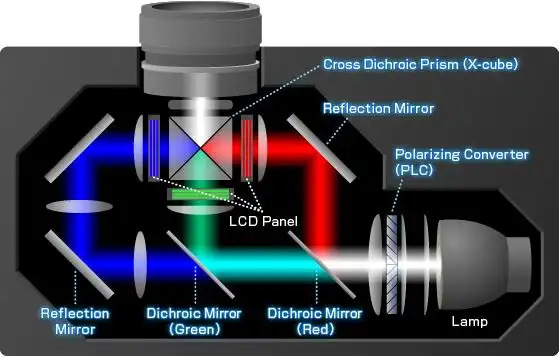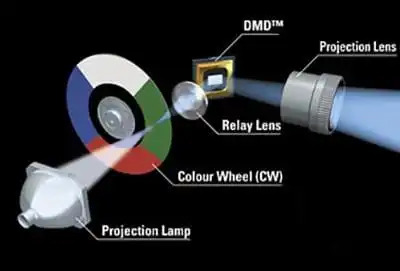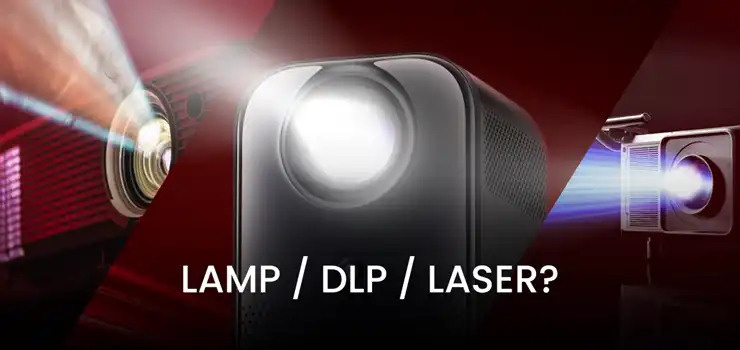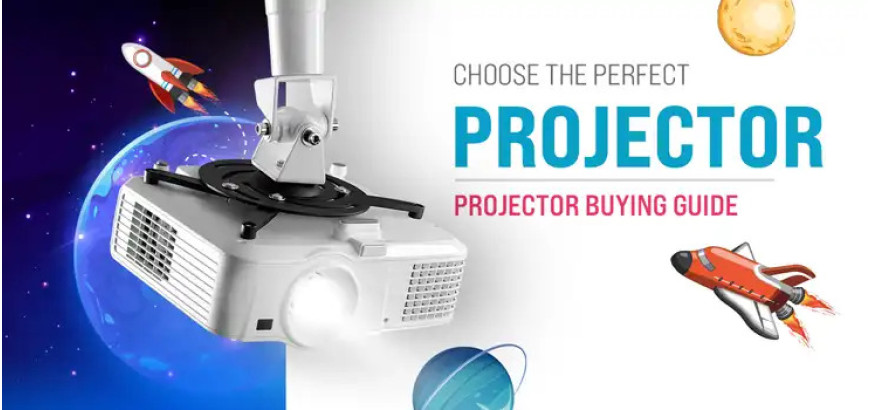In simple terms, a projector is a device that throws a still image or video on a distant surface. You can project from a computer or even the smartphone in your hands. Choosing the right projector is a hefty task. And in 2022, there’s an awful amount of features, types, and technology involved. Because there are so many things to consider, we are here to make your purchase the most satisfying one. Find all the know-how of the buying process in this article. Read to the end, and don’t stay in the dark anymore.

From Movie Theaters to Classrooms
Since the Second World War, projectors have been around us. In early times, projectors had their place primarily in the military and large organizations. When the technology evolved to digital, it became a consumer-grade commodity.
You can not find a conventional movie theater without a projector. After the 2000s people started enjoying movies at home. By the post-2010s projectors started serving in large auditoriums, wedding venues, and family get-togethers. Today, they are an inseparable part of the classrooms and meeting rooms. Modern-day office activities require regular presentations. As a result, projector demands grew substantially for conveying visual information to a large audience. Brands like InFocus, Asus, BenQ, BOXLIGHT, ViewSonic & Optoma are among the most popular choice in the consumers’ community.
Types of Projectors
We divide projectors based on various perimeters. You can divide them based on features like resolution and come up with FHD Projectors or 4K projectors. Then you may have a spectrum of use-case & portability, giving you Mini Projectors and Home-Theater Projectors, etc. But in this article, we are going to enlighten you on the categorization for mechanism, mostly. Because the mechanism is what determines the price of projectors and then comes other properties like contrast ratio or interactivity.
First and foremost, the image processing technology. The next important thing can be dialed to the light source a projector uses. Based on the mechanism, we can divide projectors into two types -
- Based on Light Source
- Lamp Projector
- LED or Laser Projector
- Based on Image Processing
- LCD Projector
- DLP Projector
With these two mechanism concerns, projectors are also categorized by projection distance, resolution, WiFi & Smart capability, and so forth. For your best understanding, we shall go through each one of them.
To understand the number of variables in categorizing projectors, first, you must know how they work. So, let’s take a glance, and then you are ready to make your ideal choice.
Light Source
To throw an image, a simple projector needs a bright light source and an image or patterned filter in the front. Projectors may use either a halide lamp, an LED panel, or a Laser light to resource necessary brightness and color for the projected scene.
Lamp
These are the most common and oldest type of projector light sources that are still on the market. Surprisingly, by quality, these are nevertheless newer projectors like LED or Laser. Lamp-based projectors use an incandescent hailed bulb at the back of the image source that beams a highly dense white light. Lamp-based projectors are at the top when maintenance comes forward. You can easily swap the lamp and find replacement parts conveniently in the market.
LED or Laser
The use of LED or Laser beams instead of a lamp light makes source lighting significantly cost-efficient. In every LED or laser-based projector, there can be a single white or three separate colored light sources for Red, Green & Blue light.
LED projectors can produce very bright, white light and can project the most soothing colors for a projector. Being LED, they don’t heat much and no warm-up time is required like their halide counterparts. It means you can instantly get a perfect picture by turning on the device. They are the most popular choice for small home projection scenarios for low prices and high mobility.
Laser projectors, on the other hand, are the pinnacle of projection technology. Using a laser as a light source gives numerous advantages. A laser produces exactly the right amount and wavelength of light. As a result, they are the most efficient, no extra light is wasted like in a lamp or LED projector. Laser projectors make the most vivid and crisp image on the screen. This is due to the color gamut being far superior to any other method of beaming in a projector.
Image Processing
After we beam our necessary light, we move forward to the processing phase. Here again, there are two ways a projector can create the intended picture. One is LCD and the other is called DLP.

LCD (Liquid Crystal Display)
LCD projection uses LCD panels to process the intended picture. When charged, the LCD creates a filter with an image pattern. Necessary pixels either allow or prohibit light to pass through as per the frame’s image. Through the LCD screen, light passes, and the final, patterned image moves towards the lenses for final projection. There can be a single or 3 separate LCDs for Red, Green & Blue light. Lights are split into RGB with the help of mirrors and filters.

DLP (Digital Light Processing)
DLP or Digital Light Processing is the latest image-projection technology. In this, the source light first passes through an RGB color wheel. As a result, the light assimilates a specific color from the wheel and then the next, instantaneously. Next, the image comes alive. This is achieved by a panel of mirrors called a DMD or Digital Micrometer device. Almost two million or more micron-sized mirrors in a chip change their reflecting direction. The mirrors correspondingly reflect the image or pattern in hand and either send or prohibit the light to move forward. This amazing technology brings us the chance for organic contrast in the final image. This is because when the mirror chip does not reflect and send light, there is organic black on the screen.
Projector Buyer’s Guide: Remember These 5 Points
Now that we have an overall idea of a projector’s mechanism, we are ready for the consumer’s concerns. Keep these points in mind when you head to the store or place your order.

1. Brightness & ANSI Lumens
The first thing a customer should remember before buying a projector is the rated light intensity. This is measured in various units, but the majority of manufacturers advertise in ANSI Lumens. Lumen is the unit for light intensity or brightness. ANSI is known as the American National Standards Institute.
What is the Ideal Brightness for My Home or Office?
Ideally, you do not want to go below 1000 ANSI lumens. We suggest this based on the most popular choice by our customers.
For Movies & Entertainment: About 2000 ANSI lumens will get you a bright enough picture to watch movies at home or living room. This brightness should give you the perfect brightness and color intensity for an immersive cinematic experience. Since you’ll most likely watch movies in a dark environment, this should serve neatly.
For Well-lit Environment: Go 3500 lumens for spaces that are typically used during the daytime. Such use cases are classrooms, corporate offices, boardrooms, and conference rooms. You want a brightness that surpasses the light coming in from the outside. It should not wash out the entire picture. Use high-contrast projectors for these scenarios where everyone gets to see the information properly.
For Wide & Open Locations: Get a projector that produces at least 5000 lumens for well-lit meetings, and as much as possible for larger or brighter venues. About 6000 lumens is standard for auditoriums and open environments. You can go 7000 or higher, but that will require extra financing.
2. Throw Distance
The throw distance is the space between the final component of the projector, usually a lens, and the projection screen. Typically measured in inches or feet. It is calculated by the capacity to zoom in or out of the image by the projector’s lens and the size of the final image you want.
How to Calculate Projector Throw Ratio
To calculate your Throw Distance first you’ll need to measure the desired image width (IW). Multiply by the Throw Ratio (TR) and you have your result. The throw ratio is determined by how much the projector needs to move backward for every 1-foot added width. So, 1.5:1 means you have to move 1.5 feet to get a 1-foot wider image.
Short Throw at Home Theater: Projectors with a throw ratio of nearly 0.38:1 can be categorized in the short throw spectrum. These are the best choice for a home theater experience. Sitting at the bottom of a screen, these throw the image from an extremely short distance. Usually comes with a fixed lens or none with the option to choose the correct lens.
Standard Throw in Classrooms & Conferences: Projectors of nearly 1.5 to 2 throw ratio fall into this category. They are standard for all types of indoor and presentation uses. From classrooms to conference halls, this range dominates.
Long Throw at Large Venue: A projector with a throw ratio greater than 2:1 is typically classified as a long throw projector. These serve the best at large venues, auditoriums, and projection halls.
3. Lamp Life
We urge the buyer to go for a longer lamp life for their projectors. Lamp life is an assumed period for a lamp before degradation. Under 10,000 hours and you will need to frequently change the source lamp. In this case, by lamp life marketers mean every type of lamp - LED, Halide, or Laser.
Remember that Halide lamps tend to burn out or even explode faster than LEDs and lasers. While lasers incorporate a significantly longer lamp life, they are also tough to change and might need a professional hand. But you can change the Halide light yourself right at your home. However, we always encourage professional service rather than destroying your valuable projector.
4. Resolution & Contrast
Resolution matters in digital multimedia projection. The Standard is 1080 and the modern trend is the 4K to 8K. With more resolution, your window for finer details opens up. More than 1080p resolution means the pixels are smaller than the standard 1080 in your projector’s body. This also leads to the realm of enjoying a higher contrast ratio and HDR in digital imagery.
5. Ports & Connectivity
Modern projectors offer various interfaces for multimedia connectivity. Note that your projectors MUST include an HDMI port. Without an HDMI you miss out on most modern Laptops and PC connectivity. VGA is also important, for they are still prevalent in many digital peripheral units.
How Can I Project From My Smartphone?
Smart features in a projector are becoming more and more popular every day. Even a few years back they were not that much of a concern. But now, smartphones are surging with high-end specs. Gaming Projectors and binge-watching YouTube, Netflix, and Amazon Prime with them are becoming more popular. Find a Smart Projector if you fancy streaming or playing from the internet with apps. For a smartphone connection, you have to find projectors with a USB 2 or USB-C interface.
Where to Buy Projectors at the Lowest Price in Bangladesh?
Always try to get your projector from a renowned technology shop, especially one that sells branded optical & imaging devices. Because projectors are intricate devices with a technology that uses light, the device needs to be handled and serviced by professionals. For your desired piece of the perfect projector, you can always visit Star Tech Online & Retail shops. Experts at Star Tech are ever ready to guide and give you the best service regarding all types of office equipment.



Comments
Mithun Rana
good article. very informative